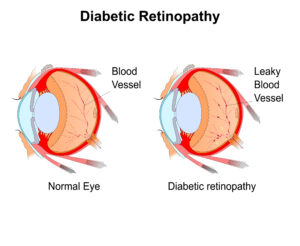
Diabetes comes with a host of potentially serious complications. Among them is diabetic retinopathy, which affects up to 40 percent of people with diabetes. Those with type 1 or 2 diabetes are vulnerable. Without treatment, patients can go blind within several years of experiencing the initial symptoms. The doctors at Mack Eye Center explain what diabetics should look out for regarding this condition.
Diabetic Retinopathy
Diabetic retinopathy is caused by high blood sugar levels that damage the retina: the layer of tissue covering the bulk of the back of the eye. Via the lens, the retina receives light and visual information to pass along to the brain. Diabetic retinopathy damages the blood vessels in the retina, in turn causing leaking and swelling. Both eyes are usually affected.
There are two primary stages of diabetic retinopathy. Non-proliferative diabetic retinopathy (NPDR) is the earliest stage, and is often asymptomatic. Diabetics may develop diabetic macular edema as a result of NPDR. With this condition, leaking blood vessel fluid accumulates in the retina. The macula, the retina’s central part, then swells.
Proliferative diabetic retinopathy (PDR) is the advanced stage of the disease. New blood vessels start growing in the retina and bleed into the vitreous, the transparent gel-like substance taking up space between the retina and the lens. Scar tissue may form. Such tissue can harm the macula or cause retinal detachment. The latter is a medical emergency.
Signs and Symptoms
Diabetic retinopathy may not produce symptoms in the early stages. As it progresses, symptoms may include:
- Blurred vision
- Impaired color vision
- Dark vision areas
- Increase in floaters
- Vision fluctuation
- Vision loss
Contact your ophthalmologist immediately if you are experiencing any of these symptoms. Not only do such vision issues demand prompt attention, but some are associated with retinal detachment.
Treatment
After diagnosis, early symptoms may not require treatment right away. The patient undergoes regular monitoring by the doctor to detect any change or progression.
Laser therapy is a common treatment for diabetic retinopathy. This procedure involves directing a laser beam toward the back of the eye. The laser cauterizes bleeding blood vessels.
Retinal laser photocoagulation stops these leaking blood vessels. A related procedure, pan-retinal photocoagulation, causes blood vessel shrinkage.
Patients may have medication injected right into the vitreous. The drugs, vascular endothelial growth factor (VEGF) inhibitors, keep new blood vessels from growing. These medications work by interrupting the signals sent by the body to grow new blood vessels.
Contact Us
If you are diabetic and are concerned about diabetic retinopathy, contact Mack Eye Center today and schedule a consultation. Early treatment can mean a better prognosis for your vision.

